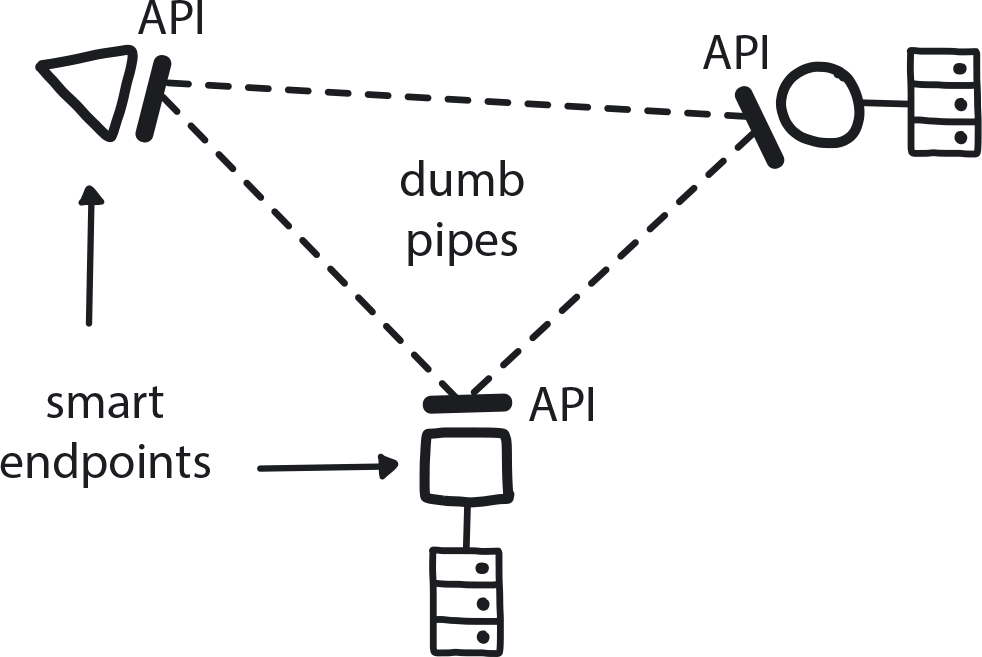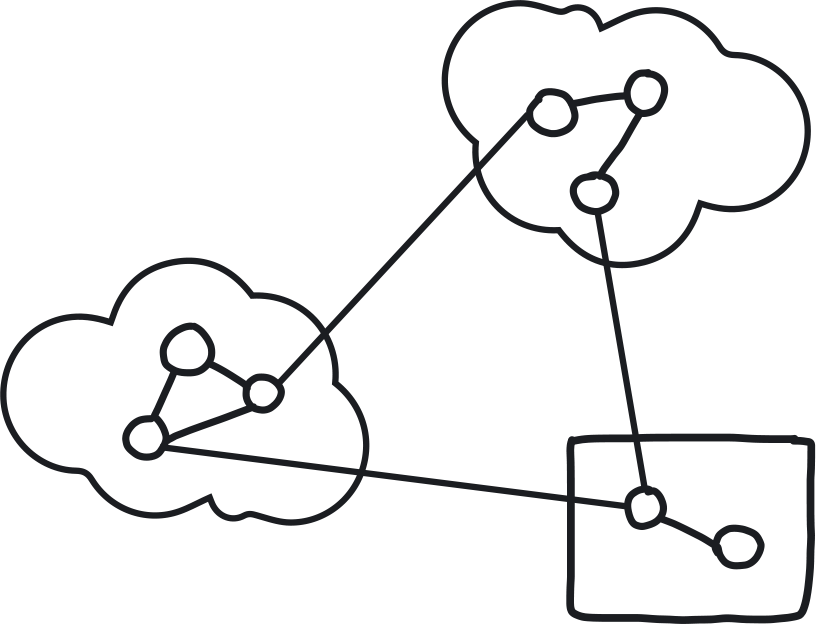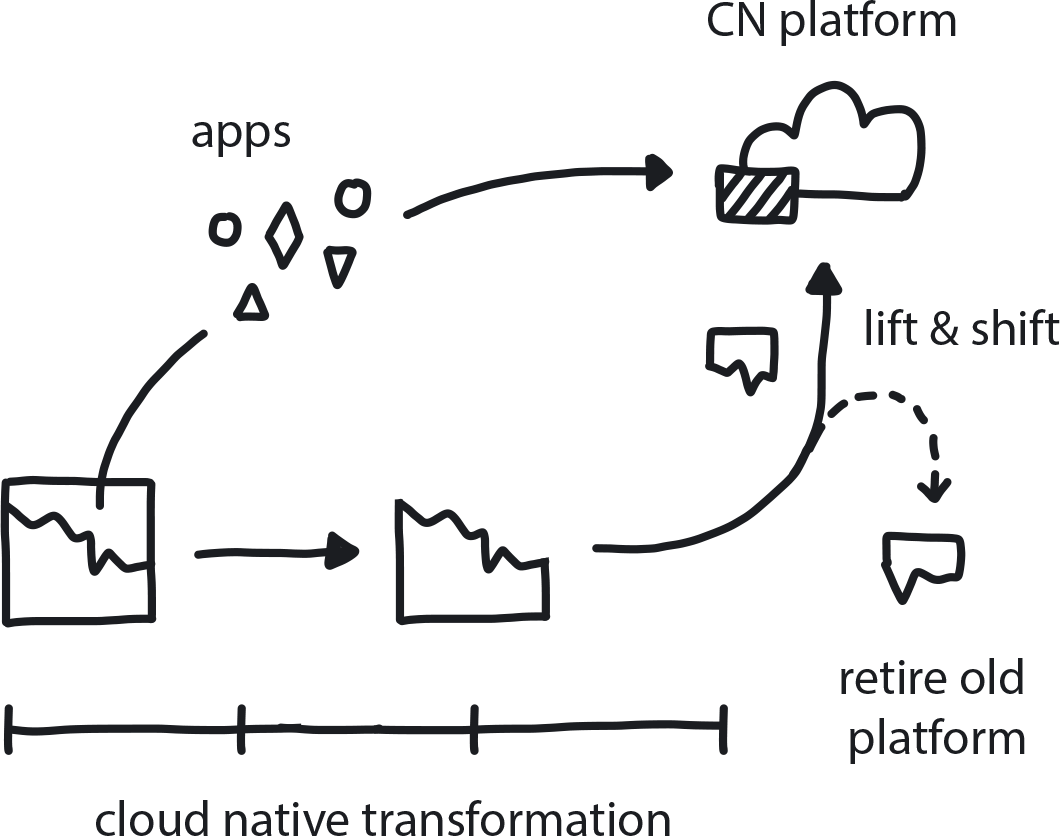Appendix A. Library of Patterns (Thumbnail Reference Versions)
New cloud native patterns are emerging constantly. To continue sharing them and extending the cloud native pattern language we have established here, please visit www.CNpatterns.org.
This is where to find the latest pattern developments, but also an online community for discussing and creating new patterns. We are inviting people from across the industry, thought leaders and influencers but most importantly everyday engineers and managers—those out there working elbows-deep in cloud native code and architecture—to contribute and participate. Hope to see you there!
A/B TESTING

Figure A-1. |
Comparing multiple versions of something (a feature, new functionality, UI, etc.) under real customer use conditions quickly gives useful data about which performs better. See Chapter 9: Patterns for Development and Process for full version. |
AGILE FOR NEW DEVELOPMENT

Figure A-2. |
Balance proficiency and innovation by building a separate time for each into your development cycle. |
ARCHITECTURE DRAWING

Figure A-3. |
A picture—or, in this case, a high-level outline sketch of your system’s basic architecture—can replace a thousand words, save time, and prevent misunderstandings. |
AUTOMATED INFRASTRUCTURE

Figure A-4. |
The absolute majority of operational tasks need to be automated. Automation reduces interteam dependencies, which allows faster experimentation and leads in turn to faster development. |
AUTOMATED TESTING

Figure A-5. |
Shift responsibility for testing from humans (manual) to an automated testing framework so the quality of the released products is consistent and continuously improving, allowing developers to deliver faster while spending more of their time improving features to meet customer needs. |
AVOID REINVENTING THE WHEEL

Figure A-6. |
When possible, purchase solutions for any need that is not your actual core business instead of trying to custom-build perfect tools. |
BIG BET

Figure A-7. |
When enough information is available, commit to a significant solution for moving the cloud migration forward. Focus on execution rather than research. |
BLAMELESS INQUIRY

Figure A-8. |
When a problem occurs, focusing on the event instead of the people involved allows them to learn from mistakes without fear of punishment. |
BUILD-RUN TEAMS (“CN DevOps”)

Figure A-9. |
Dev teams have full authority over the services they build, not only creating but also deploying and supporting them. |
BUSINESS CASE

Figure A-10. |
Before launching a cloud native transformation, an enterprise’s leadership must make sure the initiative is needed and that the benefits will justify the investment. |
CO-LOCATED TEAMS

Figure A-11. |
Teams that work together in person develop naturally closer relationships and better collaborative problem-solving abilities, which in turn nurtures greater innovation. |
COMMUNICATE THROUGH APIS

Figure A-12. |
In a highly distributed system, microservices must communicate with one another via stable and strongly segregated APIs. |
COMMUNICATE THROUGH TRIBES

Figure A-13. |
Create groups of people who have similar skills but are on different teams to cross-pollinate ideas across the company and provide valuable whole-organization perspective. |
CONTAINERIZED APPS

Figure A-14. |
When an application is packaged in a container with all its necessary dependencies, it does not rely on the underlying runtime environment and so can run agnostically on any platform. |
CONTINUOUS DELIVERY

Figure A-15. |
Keeping a short build/test/deliver cycle means code is always ready for production and features can be immediately released to customers—and their feedback quickly returned to developers. |
CONTINUOUS DEPLOYMENT

Figure A-16. |
Continuous deployment automatically and seamlessly pushes code that has been accepted in the continuous integration/continuous delivery cycle into the production environment. |
CONTINUOUS INTEGRATION

Figure A-17. |
Frequent integration of small iterative changes speeds overall delivery and improves the quality of the code. |
CORE TEAM

Figure A-18. |
Dedicate a team of engineers and architects to the task of uncovering the best transformation path and implementing it along the way. This reduces risk embedded in the transformation while the team gains experience helpful for onboarding the remaining teams later. |
DATA-DRIVEN DECISION MAKING

Figure A-19. |
Collect data, extract patterns and facts, and use them to make inferences to drive objective decision making. |
DECIDE CLOSEST TO THE ACTION

Figure A-20. |
Those nearest to a change action get the first chance to make any decisions related to it. |
DELAYED AUTOMATION

Figure A-21. |
Automate processes only after a problem has been completely solved and the solution has been run manually a few times. |
DEMO APPLICATIONS

Figure A-22. |
Teams onboarded to the new cloud native system receive demo applications as an educational starting point for building their own cloud native applications. |
DESIGN THINKING FOR RADICAL INNOVATION

Figure A-23. |
Whether faced with a radical new idea or a big problem, Design Thinking can be used as a process for first brainstorming a robust list of solutions and then narrowing it down to the best possibilities for actual exploration. |
DESIGNATED STRATEGIST

Figure A-24. |
When you’re running forward as fast as you can, it’s difficult to look around you—so appoint one person within the organization to be in charge of situational awareness. |
DEVELOPER STARTER PACK

Figure A-25. |
Provide a “starter kit” of materials, guides, and other resources to help new teams onboard to the new cloud native system quickly and with confidence. |
DISTRIBUTED SYSTEMS

Figure A-26. |
When software is built as a series of fully independent, loosely coupled services, the resulting system is, by design, fast, resilient, and highly scalable. |
DYNAMIC SCHEDULING

Figure A-27. |
An orchestrator (typically Kubernetes) is needed to organize the deployment and management of microservices in a distributed container-based application to assign them across random machines at the instant of execution. |
DYNAMIC STRATEGY

Figure A-28. |
Today’s tech-driven marketplace is a constantly shifting environment, no matter what business you are in—so your game plan needs to shift right along with it. |
EXECUTIVE COMMITMENT

Figure A-29. |
To ensure allocation of sufficient resources and reasonable delivery time frames, large-scale projects such as cloud native transformation require strong commitment from the top executive team. |
EXIT STRATEGY OVER VENDOR LOCK-IN

Figure A-30. |
Public cloud vendors can handle all aspects of building and operating a cloud native platform, and their tools are often excellent—but when committing to a vendor/technology/platform it’s important to identify an alternative solution and any costs associated with switching over. |
EXPLORATORY EXPERIMENTS

Figure A-31. |
When dealing with a complex problem with no obvious available solution, run a series of small experiments to evaluate the possible alternatives and learn by doing. |
FULL PRODUCTION READINESS

Figure A-32. |
Make sure your platform is fully provisioned with CI/CD, security, monitoring, observability, and other features essential to production readiness before you try to take it live. |
GRADUAL ONBOARDING

Figure A-33. |
One to three months before the new platform goes live, begin training a couple of teams at a time with a pause between each cohort to incorporate feedback and improve the process/materials. |
GRADUALLY RAISING THE STAKES

Figure A-34. |
In an uncertain environment, slowly increase investment in learning and information gathering; eventually you uncover enough information to reduce risk and make better-informed decisions. |
INTERNAL EVANGELISM

Figure A-35. |
Provide plenty of information about the transformation across the entire company right from the start to create understanding, acceptance of, and support for the initiative. |
INVOLVE THE BUSINESS

Figure A-36. |
The business teams and the tech teams need to collaborate to create an effective customer-feedback loop that drives product improvement. |
LEAN FOR OPTIMIZATION

Figure A-37. |
When a stable system delivers the value that’s intended and is not a target for technical innovation, focus on improving the system by continuously and incrementally improving delivery and maintenance processes with emphasis on repeatability. |
LEARNING LOOP

Figure A-38. |
Building feedback collection into the delivery process closes the loop between engineers and the people who use their products, putting the customer at the center of the product development cycle. |
LEARNING ORGANIZATION

Figure A-39. |
An organization skilled at acquiring information, creating insight, and transferring knowledge can tolerate risk with confidence and solve difficult problems through experimentation and innovation. |
LIFT AND SHIFT AT THE END

Figure A-40. |
It’s important not to approach a cloud native transformation by simply attempting a full “lift and shift” of your existing system onto the cloud. But it can be smart to move some intact pieces of it at the very end. |
MANAGE FOR CREATIVITY

Figure A-41. |
Teams charged with innovation need the open-ended freedom to experiment their way to solutions without pressure for delivering specific results on a set schedule—and the freedom to sometimes fail along the way. |
MANAGE FOR PROFICIENCY

Figure A-42. |
Teams delivering stable and highly repetitive or algorithmic work should be managed for high quality and optimal efficiency. |
MEASURE WHAT MATTERS

Figure A-43. |
People optimize their actions based on how their work is measured. Assessing the wrong things leads people to optimize for the wrong goals. |
MICROSERVICES ARCHITECTURE

Figure A-44. |
To reduce the costs of coordination among teams delivering large monolithic applications, build the software as a suite of modular services that are built, deployed, and operated independently. |
MVP (PLATFORM)

Figure A-45. |
Once Exploratory Experiments and PoCs have uncovered a probable path to success, build a simple version of a basic but fully functional and production-ready platform with one to three small applications running on it in production. |
NO LONG TESTS IN CI/CD

Figure A-46. |
Execute non-critical long running tests in the background so they don’t block delivery to production. |
NO REGRET MOVES

Figure A-47. |
Small, quick actions that require little investment of time and money but increase knowledge, reduce risk, and benefit the entire organization—inside or outside of a transformation scenario. |
OBJECTIVE SETTING

Figure A-48. |
After establishing a transformation vision, the next step is to translate it into pragmatic goals and actions for moving the initiative ahead. |
OBSERVABILITY

Figure A-49. |
Cloud native distributed systems require constant insight into the behavior of all running services in order to understand the system’s behavior and to predict potential problems or incidents. |
ONGOING EDUCATION

Figure A-50. |
Continuously introduce new ways and improve existing ones to help teams continually develop their cloud native knowledge and skills. |
OPEN SOURCE INTERNAL PROJECTS

Figure A-51. |
Use open source solutions for any software need that is not directly related to the company’s core business value. |
OPTIONS AND HEDGES

Figure A-52. |
Research has created deeper understanding, and a few potentially promising transformation paths have begun to emerge. Continue reducing the risk by focusing on the most promising options and developing them further. |
PERIODIC CHECK-UPS

Figure A-53. |
Frequently reassess vision and objectives to ensure these remain the correct direction to proceed as the business environment shifts. |
PERSONALIZED RELATIONSHIPS FOR CO-CREATION

Figure A-54. |
Solutions to complex problems are best created collaboratively by teams with high levels of interpersonal connection. |
PLATFORM TEAM

Figure A-55. |
Create a team to be in charge of architecting, building, and running a single, consistent, and stable cloud native platform for use by the entire organization so that developers can focus on building applications instead of configuring infrastructure. |
PRIVATE CLOUD

Figure A-56. |
A private cloud approach, operated either over the internet or on company-owned on-premises infrastructure, can offer the benefits of cloud computing services like AWS while restricting access to only select users. |
PRODUCTIVE FEEDBACK

Figure A-57. |
People are more engaged and creative when they feel comfortable receiving constructive information about their behavior and giving the same in return. |
PROOF OF CONCEPT (PoC)

Figure A-58. |
Before fully committing to a solution that can significantly affect the future, build a small prototype to demonstrate viability and gain better understanding. |
PSYCHOLOGICAL SAFETY

Figure A-59. |
When team members feel they can speak up, express concern, and make mistakes without facing punishment or ridicule, they can think freely and creatively and are open to taking risks. |
PUBLIC CLOUD

Figure A-60. |
Instead of using your own hardware, rely on the hardware managed by public cloud vendors whenever possible. |
REDUCE COST OF EXPERIMENTATION

Figure A-61. |
When someone has an idea that requires validation, the costs of doing experiments around it needs to be as low as possible. |
REFERENCE ARCHITECTURE

Figure A-62. |
Provide an easily accessible document laying out a standardized system architecture for all teams to use for building their applications/components. This ensures higher architectural consistency and lowers development costs via better reusability. |
REFLECTIVE BREAKS

Figure A-63. |
Build periodic times into the business delivery cycle dedicated to reviewing current strategy in light of shifting market conditions or other new information. |
REMOTE TEAMS

Figure A-64. |
If teams must be distributed, whether across a city or a continent, build in regular in-person retreats/work sessions as well as robust channels for close and free-flowing communication. |
REPRODUCIBLE DEV ENVIRONMENT

Figure A-65. |
Developers need to test their daily work in an environment that is easy to spin up and that matches production tooling as closely as possible. |
RESEARCH THROUGH ACTION

Figure A-66. |
People can sometimes use research as a way to avoid making decisions, so hands-on learning through small experiments builds confidence and jump-starts progress. |
RISK-REDUCING DEPLOYMENT STRATEGIES

Figure A-67. |
Employ release tactics to decrease the chance of problems happening when changes are introduced into the production system. |
SECURE SYSTEM FROM THE START

Figure A-68. |
Build security into the platform beginning with the earliest versions to ensure your distributed system is unbreachable by design. |
SELF-SERVICE

Figure A-69. |
In cloud native everyone can do their own provisioning and deployment with no handoffs between teams. |
SERVERLESS

Figure A-70. |
The soon-to-arrive future is event-driven, instantaneously scalable services (functions) on the cloud. |
SRE TEAM

Figure A-71. |
The SRE (Site Reliability Engineering) team helps the development teams to maintain and improve the application (not the platform or infrastructure). |
STRANGLE MONOLITHIC APPLICATION

Figure A-72. |
Gradually split pieces of the old monolithic application one by one, re-archtect them into services, and move them over time to the new CN platform. |
STRANGLE MONOLITHIC ORGANIZATION

Figure A-73. |
Just as the new tools, technologies, and infrastructure gradually roll out over the course of a transformation initiative, the organization and its teams must also evolve to work with them properly. |
THREE HORIZONS

Figure A-74. |
Proportional allocation of resources among delivery, innovation, and research makes an organization responsive to change while reliably delivering core business value. |
TRANSFORMATION CHAMPION

Figure A-75. |
When a person is promoting a good new idea that can take the company’s goals and values into the future, recognize and empower them to lead the action. |
VALUE HIERARCHY

Figure A-76. |
When an organization’s values are clearly stated and prioritized, as well as fully internalized across the company, people have the basis for making day-to-day decisions without needing to seek consent or permission/approval. When an organization’s values are clearly stated and prioritized, day-to-day decisions can be made without seeking consent or permission/approval. |
VISION FIRST

Figure A-77. |
Defining a high-level transformation path as the very first step helps set the right course through an uncertain environment. |
